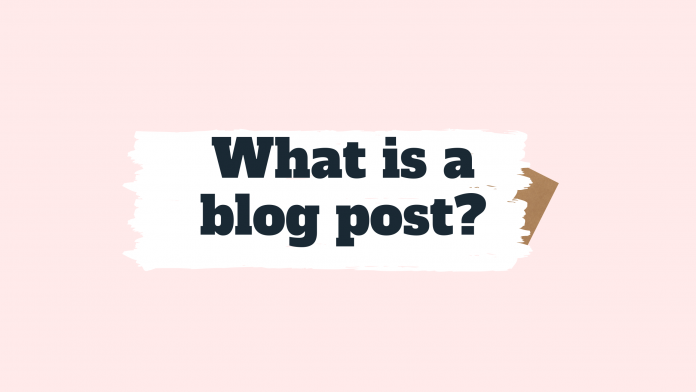If there is a marketing term that has become popular in recent years, it is undoubtedly “post”. And it is that posts have become a very important tool for the marketing strategies of any company : that is why it is essential that you not only know what they are, but also how to create them so that they are attractive, convincing and useful. And you, do you want to delve into this concept and learn how to create effective posts?
Next, I’ll explain everything you need to know about posts and show you the ten-step method to write posts that will seduce your audience.
What is a post?
“Post” is an English word that is translated as article , message or publication . In the world of marketing, which has adopted many Anglo-Saxon terms, we use it to talk about different content:
- Post as a social media post
- Post as a message within a forum
- Post as a blog post
In today’s article I will focus on posts as blog entries because they are the most complex and therefore the hardest to master and create. However, once you control the process, these posts can help you improve the results of your company, although for this they must always meet two characteristics :
- That the content is valuable enough that users are attracted to read it . Keep in mind that your audience will only read posts that interest them, that arouse their curiosity and that serve them something, so don’t write to write! Take some time to research what topics your audience likes and what they want to learn about.
- That they are optimized for SEO, that is, that it is written and configured to position well in Internet search engines and is easily found by users.
Why write posts?
According to data from DemandMetric, 70% of users prefer to learn about a company through the posts it publishes on its blog rather than through advertisements . In addition, 68% spend time reading content published by companies .
On a business level, HubSpot’s State of Inbound study indicates that 82% of marketers get a positive ROI from their content strategy . Content Marketing Institute also analyzed the impact in terms of the conversion of companies and found that companies that regularly publish posts on their blog have a conversion rate 6 times higher than those that do not .
Types of blog articles
Now that you are probably convinced of the importance of publishing posts on your corporate blog, you may have doubts about how to get started.
An easy way to take the first steps in your creative process is by knowing the most common formulas for writing articles :
1. Explanatory post of a concept (What is …?)
As you can imagine, this type of post is the one that explains the characteristics of something, how it is, what it is for … As it is a presentation, you will have to give details and be precise. One trick is to imagine that you are speaking to someone who has never heard of it before.
2. Post tutorial (How …?)
If the explanatory post should talk about how something is, the tutorial post should explain how it is used or how something is done. Therefore, your goal is to help the reader solve a problem and teach them a new skill. In this case, a dotted structure is ideal to shape your post and make each step clear and defined.
3. Pillar post (Complete guide to …)
If you are going to write a long article in which you talk in great detail about a topic, the formula you should use is that of the Pillar post. It is a type of post that collects all the useful information for your audience about a topic: what it is, how it is, what it is for and what it is not for, how it is used, where to buy it, what models exist, how much does it cost …
4. Post compilation (List of …)
The compilation posts are structured as a list and are very useful to help the public to visualize and order the steps they must follow to achieve their objective. Also, by separating the information into small paragraphs, they are easier to read.
5. News post
They are the type of article that is used to talk about news or news of the moment. These posts deal with issues that are present in the now and affect your audience today, that is why they arouse a lot of interest. On the other hand, if you write a highly topical post, the public will tend to see you as an authority on the subject who is aware of the world around them and how their sector is evolving, and will trust you and your brand more.
6. Posts with interviews
When you want to write a post about an interesting topic for your audience, but you are not an expert or have enough information, the best option is to interview someone relevant to your buyer persona who can provide interesting data. Interviews are also useful for giving your audience different points of view on an issue.
7. Case studies
Post about case studies serve to strengthen your arguments and demonstrate that you write with knowledge of the facts. And the thing is … you can’t just ask your audience to trust you! That is why you have to prove that what you are saying is true. For example, if you say that your product is the best on the market, prove it by writing a post in which you compare the performance of your competition’s products with yours and show data that confirms it.
8. Guest post
In this case, it will not be you who writes the article, but someone invited, a person relevant to your audience with whom you have contacted and who can offer a different vision of the topics you are talking about. This, in addition, will open the door to new audiences and will bring freshness and variety to your blog.
The importance of EAT factors
After the arrival of Google Bert , three factors have taken on special relevance to ensure that a post reaches good positions in the search engines. They are the EAT factors , whose acronyms correspond to the concepts of Expertise (experience), Authoritativeness (authority) and Trustworthiness (trust) .
This means that for Google to see your content favorably, it will take into account (among many other factors):
- Your degree of experience in the subject you are writing about.
- The background or reputation of your website.
- The security that your site transmits.
Taking this into account, it is important that you check if your website is in a good position to offer users a good experience and that you bet on generating content from your field of activity . In this post on our blog you can find recommendations to comply with Google EAT.
How to write a blog post?
With all these concepts on the table, the moment of truth has come: write what is perhaps your first post or blog article. Let’s see the steps to follow :
1. Define the theme of the article
This first step may seem very obvious, but considering what we have discussed about the Google EAT factors, it is not to be taken lightly.
Choose a topic for your article in which you have real experience. The article will be much easier for you to write and you will be able to cover all the angles related to the subject because you will know it in depth.
Sometimes the impostor syndrome can make an appearance and you may think that you are not an expert in any field or that you cannot write about anything interesting, but I assure you that this is not true. What is routine for you may be content of interest to your target audience.
In InboundCycle, for example, we write posts about topics that are part of our day-to-day life at the agency ( here one that has been writing content since 2012 🙋♀️).
2. Identify keywords of interest to your buyer persona
Once you know what you want to write about, you must find the keyword or keywords that are commonly used to search for this type of information .
Take some time to write down all the options that come to mind and analyze if they are adequate considering the volume of searches they have per month and the difficulty to position themselves. Then, check your ideas against data using some of the keyword research tools .
Keep in mind that the more difficult a word is or the fewer visits it gets per month, the less impact the publication of this post will have on your website traffic.
3. Research to cover all angles
Even if you are an expert in the field, it is important that you give a complete vision of the subject you are writing about. Find out about what is covered in articles similar to yours to make sure you don’t miss out on anything.
If in your sector there are statistical studies on the subject you are going to discuss, it is also a good time to collect this data and include it throughout your content, mentioning their authors.
4. Write the content
Now comes the crucial moment of the process: writing.
If you fear a blank page, to begin with, it will be very useful to define a point scheme that will help you structure the topic you want to talk about. For example, in this article that you are reading the simplified structure was this:
- Introduction – What is a post
- Why they are important in marketing
- Most common post types
- Google EAT
- Steps to follow to write a post
Knowing what topics and subtopics to develop has allowed me to write in a more orderly way without leaving anything to discuss.
Broadly speaking, the structure of an article usually consists of three parts:
- Introduction aimed at generating curiosity
- Development of the chosen theme
- Motivating conclusion or that encourages the user to comment
With your simplified outline and structure in mind, you have everything on your side to write a good article!
5. Review the content
It is very likely that as soon as you finish writing you will be happy and satisfied to have finished, and think about publishing as soon as possible. But don’t do it! Spend some time reviewing the content .
Reviews (yes, plural!) Are important because they allow you to:
- Identify repetitions in your text
- Correct possible spelling mistakes
- Add information sources
- Check the rhythm and fluency of the text, among others
If you accept advice, it is best to find someone from your company (or a family member or friend with similar interests) to also review your post . By not having been involved in the writing, it can give you a different perspective that will help you improve the content.
6. Give it a title
Although it seems strange, now is the best time to choose the title of your content. Why? Well, because after the writing you will have the certainty of what topics are covered and what aspects you want to highlight to attract the attention of your target audience .
There are standard formulas that can help you write good headlines:
- The [#Number] secrets about [Thematic]
This type of headline is designed to arouse the curiosity of those who read them and encourage them to continue reading to discover what are those secrets that you are going to reveal about a topic that interests them. For example: The 5 secrets to writing crime novels. - Everything you need to know about [Topic]
In this case we are also using curiosity to awaken in the reader the desire to continue reading and learn more. This formula is very useful when you write in-depth posts in which you thoroughly analyze a topic or talk in great detail about something. For example: “Everything you need to know about intermittent fasting.” - [Topic]: Complete guide (Current year)
These titles are perfect when you are talking about an annual novelty (for example, the poster of music festivals) or also about something that no longer changes throughout the year (for example, the dates of the official language school), because they communicate to the reader that the information is complete, that is, that it has in a single post all the data that it needs to know. For example: “Aid to entrepreneurs: Complete guide 2022”. - The most common [# Number] errors in [Topic] and how to solve them
Bet on this formula to show your audience that you want to help them with your knowledge on the topic that interests them. The reader will be interested in knowing how to improve, and will read your post to find out if they are making mistakes that prevent them and how they can avoid them. For example: “The 10 most common errors in SEO onpage and how to fix them”. - The [#Number] best tools for [Thematic]
These headlines serve to communicate to your audience that you are going to present them with a list of tools that may be useful to develop the theme that interests them. With this formula you will convey conciseness and make it clear that the content of the post will be useful.
- [Tool / Service] vs [Other Tool / Service]: which one do you need?
This title will be useful when you are comparing characteristics of two products or services from the point of view of your audience, so it is very useful to capture their attention and finish reading your post.
7. Upload the post to your blogging platform
Now that you have all the content ready, it’s time to prepare it for publication on the blogging platform you use.
If you don’t have a blog yet, here are two articles that we have published in which we review some of the most popular tools:
Whatever your platform, in this step it is important that you take the opportunity to include graphic resources (images, infographics, lists, section titles) to facilitate reading. Keep in mind that, according to Optinmonster, 43% of readers admit that they only browse the content , so a clear and visual structure will help you get your message across in all cases.
8. Optimize the post for search engines
We have already reached the end of the process, and we do it with a task that will be differential in the success of your post in the medium and long term: search engine optimization or SEO.
Do you remember that at the beginning of the creation of the post we chose a word or keywords? Now is the time to check that you have been using them naturally throughout the text, but especially importantly in titles and subtitles of your article. Keep in mind that, although Google is getting smarter, it is still a search engine and this will make it easier for them to interpret your text.
9. Include a CTA
Before publishing your article, there is one last step that many people forget, and that is to add a call-to-action (CTA) to take readers one step further in their process of getting to know your company .
After reading your post, what would you like the user to do? Here are some ideas:
- Subscribe to your blog to be informed of your news
- Download related content that continues to position you as an expert
- Visit a specific page on your website
- Read related content
- Leave a comment
Whatever your choice, include this action within the text (if it fits with the flow of your writing) with an imperative phrase, or take the opportunity to include a button or banner at the end of your article .
10. Post it!
Now yes… the moment of truth has come, the moment for which you have been working so hard: the moment to publish your post!
Choose the publication date based on your content plan and enjoy the moment .
BONUS: content dissemination
If you want your post to go as far as possible, be sure to spread it on your social networks, through your personal and professional contacts, or send it to your database .
Also keep in mind that if your blog has a comments module, you should keep track of the new comments you receive and respond to them.
What do you think of the process of creating a blog post? Each time you work on an article, it will be easier for you to go through all the steps and you will find the writing rhythm that works best for you.








